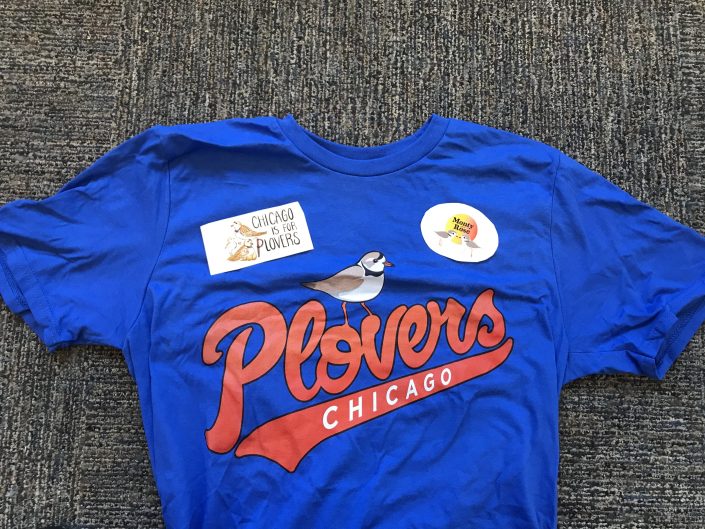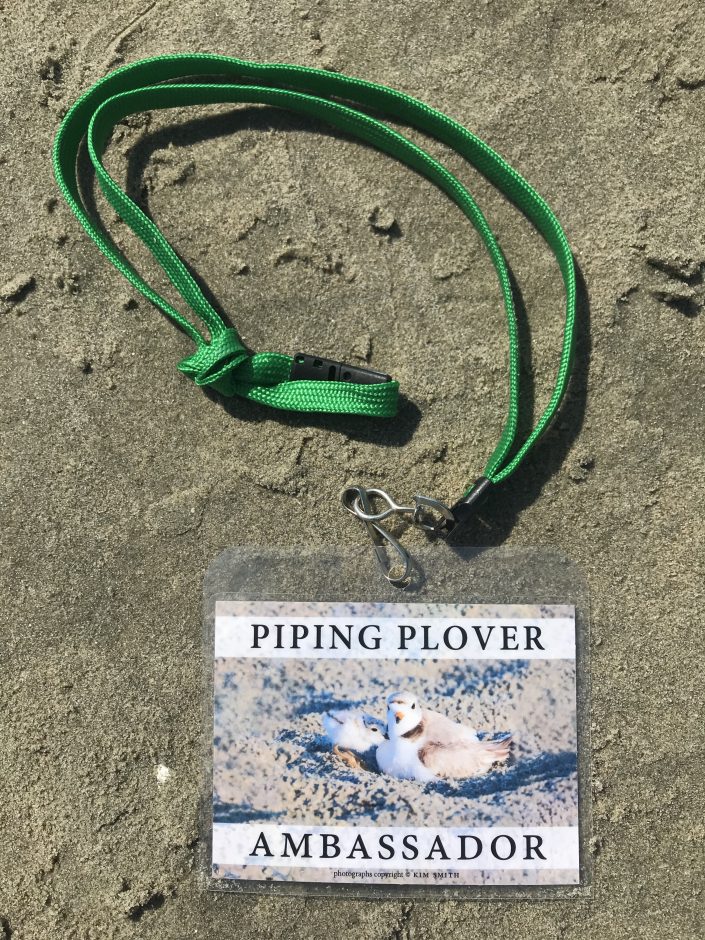Meeting Monty and Rose, Piping Plover Ambassadors
By Todd Pover, Senior Wildlife Biologist

Monty and Rose were hardly strangers when I finally met them “in-person”. I had been admiring Chicago’s famous pair of piping plovers for nearly two years. I had read the adoring newspaper headlines about them and followed them closely on social media. I had seen, even hosted a screening for the short film made about their story. I proudly wore a hat emblazoned with their colorful logo.
From a strictly biological perspective, Monty and Rose aren’t much different than any other piping plovers; they have the same distinct markings, exhibit the same behaviors, and face the same threats that have landed plovers on the endangered species list. But there is nothing ordinary about this pair when it comes to the attention afforded them and the excitement they’ve created.
So early this summer I found myself on a plane headed to Chicago to experience the Monty and Rose phenomenon firsthand. Along for the pilgrimage were Kashi Davis and Emily Heiser, who head up New Jersey’s beach nesting bird program, and with whom I’ve share nearly my entire career. With nearly 60 years of “plovering” between us, you wouldn’t think we’d have much to learn from yet another pair of plovers. To be honest, the trip was as much about being inspired by Monty and Rose and the people involved in their story, as it was about anything else. But on the practical side, I was especially interested in how they managed to pull off a dawn to dusk volunteer monitoring program from incubation to hatch to fledge. And I really wanted to know how they generated all that excitement.
The novelty factor accounts for some of the appeal, the first plovers nesting in Chicago in many decades. But interest in Monty and Rose has continued to rage on several year running now, and a second film is scheduled for release in September, so it isn’t just that. Improbability also plays a part, a small pair of shorebirds and their even tinier chicks nesting on a busy city beach in the shadow of skyscrapers. The naming of the birds, a reference to Montrose Beach, where they nest, also seems to play an important role in the connection people feel for them. There is a great sense of pride – they are their plovers. And with just one pair at this site (and in the entire region), all the attention is funneled to them.

You feel the excitement the moment you walk on “their” beach. People constantly pop by to ask how Monty and Rose are doing. The volunteer monitors happily trade personal stories about them or offer a look in their scope to get a closer peak. Strangers wander over to ask what everyone is looking at. We met Bob Dolgan, the creator of the Monty and Rose film (and its upcoming sequel), and Tamia Itani, the pair’s “plover mother”, organizer of the volunteer effort, and now author of a Monty and Rose children’s book. Both had their own take on why the Monty and Rose story has gone viral, although I’m not sure I’ll ever know exactly what that “secret sauce” is. No matter, I left Chicago completely inspired by Monty and Rose and their protectors, recharged and ready to carry on with my own plover projects back home.
A few days after returning from Chicago, I took a day trip up to Gloucester, Massachusetts to meet some members of another piping plover volunteer group. Like the Monty and Rose crew, they annually help shepherd one pair of plovers (actually, they have two pairs this year) through the perils of nesting on a city beach, although Good Harbor Beach is decidedly quieter than Montrose Beach in Chicago, at least on the mid-week morning I visited. This group also manages to staff the beach with monitors from dawn to dusk on most days and has its own Facebook page that it maintains to educate the public and generate enthusiasm for their community’s plovers. They have been doing this longer than the Monty and Rose effort, but quietly out of the spotlight. They proudly wear their Piping Plover Ambassador badges.

Seeing those badges made me realize that although the Monty and Rose story has been invaluable for creating interest in plover conservation – piping plovers are definitely having a “moment” thanks to their story – it’s the hundreds of monitors who are the real piping plover ambassadors. I started my own “plover career” 28 years ago as a volunteer. I was immediately and inexplicably smitten by piping plovers, although I didn’t realize it would completely change my life. I’m just as captivated by piping plovers today and I remain equally inspired by my fellow protectors, paid and volunteer, who steadfastly fight to help maintain a place for piping plovers in our world. And provide them a voice.
Discover more from Conserve Wildlife Foundation of NJ
Subscribe to get the latest posts sent to your email.
Leave a Comment
Congratulations on taking this memorable journey, and thank you for honoring the Plover-Savers of Chicago. I remember being told that no plovers had nested there since the late 1800s. It will be a joy to see this film. cfe
Thanks for sharing your journey with us, Todd. So cool that you all visited the Windy City to see Monty and Rose in-person!
Great article Todd! Thank you for the shoutout for our Good Harbor Beach PiPl Ambassadors program. It was pleasure to meet you at GHB. We’re such fans of you , your team, and Conserve Wildlife!
Thank YOU, Todd (and your wonderful team) for leading by example and always at the ready to offer support, advice and for constantly encouraging the team spirit…because we are all Team Piping Plover.
Monty and Rose’s existence and their nesting success in Chicago stands on the shoulders of giants in conservation, and decades of dedicated and very loving people trying to bring back Great Lakes Piping Plovers from the brink of extinction. Before there was Monty and Rose in Chicago, there was Bahama Mama and Little Guy, and YOGi who continues to breed at Silver Lake State Park under the watchful eyes of young monitors. There were all the monitors who made sure little Rosie and little Monty hatched and survived to fly to IL, FL and TX and come back to Waukegan and Chicago to nest. The city of Chicago, its people, media, wildlife agencies and volunteers adore Monty and Rose and their chicks and have given them a strong voice, but we are deeply grateful to all who preceded us in loving Piping Plovers and giving them a fighting chance across all populations. Thank you for this wonderful piece, Todd. And please come back and visit! We loved having you, Kashi and Emily.
One of our best adventures! What a joy to share the experience with you and Em! ❤️
Thanks to everyone who submitted comments about this blog! It was one of my favorites to write so the positive feedback is much appreciated. And also, nearly everyone who commented is a “star” plover ambassador in their own right, having committed a career or significant volunteer effort to protecting piping plovers somewhere in the Great Lakes or Atlantic Coast ranges! I admire you…and keep up the good fight!
Thanks for sharing your experience!!
You, Kashi and Emily truly are heroes in my book.
You all continue to inspire me.
PIPL people are awesome by definition. I am so lucky to have met and worked with so many of your crew… At the risk of leaving someone out, Michael, Jess, Meg, Rebecca, Jesse, Pam, David, another Meghan, Taleen…
You inspired me years ago when you spoke for the Monmouth County Park System.
And, Kashi I still think about your presentation at the Monmouth County Audubon Society and wonder what a beautiful Plover Park we would have had if we allowed the Mantoloking breach to remain after Sandy.
Great story Todd! You can always captivate an audience with your writing which is definitely a part of advocating for piping plovers!
Todd, what a great story, and you are a true plover ambassador as we know very well from your trip to White Point in Nova Scotia. You were an inspiration to Donna and I and your enthusiasm was contagious! I think that the secret sauce is for people to think of the plovers as “theirs”, not that plovers can be owned, but some form of public attachment really seems to work. We have missed not having “our” plovers back at White Point for two summers now, but we still know where they are and how they are doing. They are still “our” plovers! And of course, banding is a huge part of this success. Thanks to all of the plover workers and volunteers. Keep up the writing, Todd!
Comments are closed.